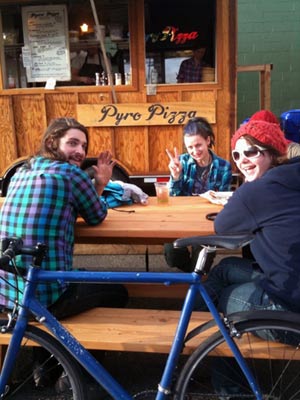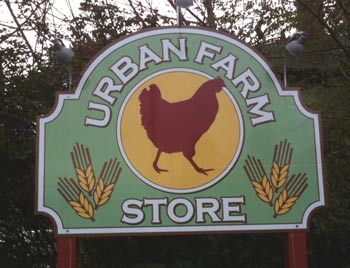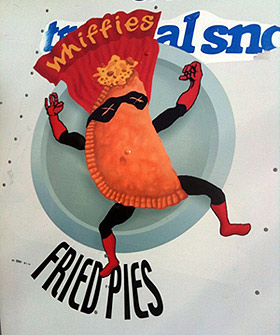I have been practicing community cultural development work for 25 years, and I am very interested in how we support local culture to create stronger, more humane, creative, and sustainable communities. I seek to support the context and environment in which culture can bubble up and flourish. Within this context of working cooperatively to build a stronger community, I am fascinated with how young people are moving forward, seldom with a detailed plan or more than minimal resources, to create a variety of places, enterprises, and activities that greatly enhance the quality of life in Portland.1
Portland is becoming a Mecca for younger people in their 20s and 30s. Whether they finally stay or not, raise families, and eventually retire here is, of course, yet to be seen. But in many areas of the city it is younger people that have the creative energy that makes Portland a vibrant place to live. What they may lack in comprehensive planning (at least of the sort that I am most familiar with), they certainly have a vision of the kind of place where they want to live and how they want to live there.
These elements of youth culture in Portland appear to value idealism, risk-taking, and action. This is consistent with my work with community groups over the years: I have learned that the ability to risk, to try something new, is exactly what communities need in order to look at their capacities in new ways and, ultimately, solve problems. Portland feels at times to me much like the neighborhoods in Berlin (where I lived for one year) which have a constant influx of young people who are constantly creating and starting new businesses and activities.
Cultural Participation
While many, if not most, non-profit organizations in the United States are experiencing enormous budget cuts, and transforming to meet changing trends in how people participate in culture, Oregon boasts a higher than average rate of cultural participation. A recent study from the National Endowment for the Arts also suggests that increasing numbers of people are seeking cultural participation in active, informal ways, such as making music with friends and loosely-structured community-based groups.2
Holly Sidford, president of Helicon Collaborative, a strategic planning and development team, spoke at a recent forum sponsored by the Oregon Arts Commission, and correctly observed, based on this study, that “people (in the U.S.) are moving—have moved—toward more interactive forms of cultural activity that give them opportunities to participate before, during or after the “arts event.”3 She went on to describe an “exploding” of technologies that allow us to find and consume cultural products, an amazing expansion of options to partake of arts and culture outside of the avenues offered by typical nonprofit cultural organizations. A striking example of this is the informal associations that characterize Portland’s music scene, as discussed below.
About Portland and Oregon
Portland has long been known as a city with an excellent quality of life, and consistently rates well for livability compared to similar metropolitan areas. Unlike many U.S. cities with troubled downtowns. Smaller blocks (200 x 200 feet, 61 x 61 meters) than most U.S. cities help to create a vibrant downtown and encourages people to think of downtown in very personal terms. Portland is also known for neighborhoods which boast a strong sense of community with active participation of residents in local decision-making on issues of urban planning, neighborhood design, transportation, and so on.
Portland, too, is well-known for its extraordinary natural environment. The Pacific Ocean, Cascade Mountains, Columbia River Gorge, and the high desert region of Eastern Oregon are all within easy access of the metropolitan center. Access to the outdoors has always attracted people, along with a temperate climate which permits outdoor activity most of the year. Average minimum temperature in the coldest month of January is 34°F; average maximum temperature in the hottest month of August is 80°F.4
Portland is also a city of contradictions. There are strong elements of progressive thought and action in Portland, strong neighborhood identity, yet it remains politically a relatively conservative city when compared with our urban neighbor Seattle to the north and, particularly, San Francisco to the south—see, for example, a recent ranking of the “most liberal-friendly” cities and counties in the United States.5 However, we are also among the least ethnically diverse cities in the country and have a history of racism, especially toward African Americans.
Portland’s unemployment rate remains higher than the national average as well as higher than the neighboring states of California, Washington and Idaho.6 Portland also does not rate well in new job development, especially compared to cities which are also attracting younger people (see below). Portland places a great deal of its economic hopes on being the greenest city in the nation, a reputation already well-established (see below), with a strong can-do attitude that supports both innovation and small businesses.
In 2008, 573,593 lived in the City of Portland, with a total of 2,191,785 people in the Portland Metropolitan Service Area (the counties surrounding Portland). The region’s population increased by more than 263,904 people between 2000 and 2008, a 14% increase. The population is projected to reach 2.8 million by 2025. Regional growth in and around Portland typically outpaces national growth. The median age for metropolitan area residents is 37, with 42% of the population between 14 and 44 years and 16% over 60 years.7
Measured by total employment, the size of the regional economy has grown 119% between 1975 and 2006. In 2006, the area gained 33,000 jobs, a 3.4% increase from 2005. The Portland Development Commission, Portland’s economic development agency, notes that “several key clusters show potential for growth, as do the state’s unique niches in bicycle frame building, craft brewing and distilling, and the manufacturing of coffee, tea and other beverages.”8 Interestingly, these industries are all directly related to the urban youth culture discussed here.
Census data and demographic studies over the past ten years show that Portland is consistently among the top five urban areas in attracting college-educated younger people (approximately 25 to 34 year old population). Joseph Cortright, an economist with Impressa Consulting, argues that attracting talented younger people to an urban area is key to the positive economic development of that region. In a recent paper for CEOs for Cities, Cortright analyzed recent census data and concludes that Portland, Oregon, and Charlotte, North Carolina, were “the most attractive places to talented young people among the top 50 U.S. metropolitan areas.”9 To illustrate, Conor Dougherty’s recent Wall Street Journal article quotes Rachel Franklin, Deputy Director of the Association of American Geographers, describing what she calls “youth magnet cities.” “The Portland area’s critical mass of young professionals,” Dougherty observes, “means it has [what Franklin terms] ‘sustained attractiveness’ for other young people looking for a place to settle down.”10
However, while Portland is doing well attracting newcomers, especially younger people in their 20s and 30s, it is not so successful at creating new jobs. Portland was compared to Austin, Texas and Raleigh, North Carolina (also communities attracting newcomers). “From the first quarter of 2001 to the first quarter of 2009, Austin created 79,000 jobs (11.8% growth) and Raleigh 55,000 (12.8%), while Portland created just 10,000 (1.1%).11 The U.S. unemployment rate was 10.4% in February, 2010, and was 11.1% for the Portland Metropolitan Statistical Area.12
Being Green
Oregon and Portland have long been known as places that attract people with a strong respect for the natural environment, and Oregon has a history of environmental activism. The Oregon Bottle Bill, passed in 1971, was the first of its kind in the nation. It supported recycling by requiring that cans, bottles, and other containers of carbonated soft drink, beer and (since 2009) water sold in Oregon be returnable with a minimum refund value.
Oregon is also famous for its leadership in establishing organic food certification. Oregon Tilth, (established as Willamette Valley Tilth in 1982) is one of the oldest organic food certification system in the United States. The Portland Metropolitan Area is also known for its progressive urban growth planning which protects rural farmlands close to the city.
In 2010 Portland ranked first among 43 U.S. metropolitan areas in a report on America’s “green cities.”13 The “Green Cities Index” ranks metropolitan areas on a variety of environmental factors, including traffic congestion, transit use, water quality, carbon emissions, LEED-certified projects and number of “green” jobs. The Portland region received high ranking for having the second most LEED-certified building projects in the country and for having minimal urban sprawl. (LEED stands for Leadership in Energy and Environmental Design, a nationally recognized standard, developed by the U.S. Green Building Council as the standard for green building design and construction.)
Portland is also known as a bicycle-friendly city, and for several years has been rated by Bicycling Magazine as the best city for bicycling in the U.S. We have recently been rated #2, behind Minneapolis. Portland’s Mayor Sam Adams feels Minneapolis gained “extra credit” for people biking in Minnesota’s snowy winters.14 I have been riding a bicycle in Portland for over 20 years, and I can easily see the influx of young riders. Having more bicyclists on the street also contributes to changes in the culture of driving in Portland. Automobile drivers appear more aware of bicyclists, as evidenced by the increasing number of dedicated bike lanes on major thoroughfares.
One striking example of green innovation within city government is the recent move to coordinate the creation of new bike boulevards (adjacent to streets) with the planting of bioswales (landscape elements designed to remove silt and pollution fromstormwater runoff) which also reduce the amount of rain that goes into Portland’s sewer and storm water treatment systems. Bioswales also slow traffic and create a safer environment for bicyclists. Funding these two green endeavors collectively will save money in the long run.
Food Culture in Portland
Portland has a strong reputation as a city very proud of its food and drink. Young people in Portland are a serious part of this movement on all levels—as entrepreneurial business owners, workers, and consumers of goods.
Portland has a reputation for its coffee shops and microbreweries, subcultures which not only fuel the local economy but provide important gathering places for people—very much in the manner of traditional European “café culture.” These places aid in creating what Robert Putnam describes as the “social capital” (social engagement and networking) which is essential for the development and maintenance of healthy communities.15
There are 35 breweries operating in Portland, more than any other city in the world. Several of these companies are working on making their first beer.16 The Portland metropolitan area is also the largest craft brewing market in the United States. In 2008, a new Oregon Distillers Guild was formed to support the growing number of artisan distillers (more than any other state). Portland also consistently ranks in the top five U.S. cities regarding number of coffee shops per capita.
The Slow Food movement (founded by Carlo Petrini in Italy in 1986) represents much of what is happening with food culture in Portland right now. Seeking to preserve traditional and regional cuisine, this movement promotes farming of plants, seeds and livestock characteristics of the local ecosystem. As Slow Food Portland notes on its Web site “slow food seeks to reconnect people with the food they eat and the cultures, community, and production behind.”17
Ecotrust, a Portland-based non-profit organization whose mission is to “inspire fresh thinking that creates economic opportunity, social equity and environmental well-being” supports the Slow Food movement locally through its Food and Farms Initiative.18 Its three primary programs are: 1) Farm to School which supports the use of locally grown, processed, and manufactured foods in local schools; 2) Edible Portland, a quarterly magazine which celebrates local, seasonal foods from the region; and 3) Market Connections: FoodHub, an online directory and marketplace that makes it easy for regional food buyers and sellers to find each other, connect, and do business. Neighborhood cafes such as TOAST are utilizing Market Connections, revitalizing neighborhoods, supporting local farmers, and offering excellent cuisine.19
Lola Milholland, 25, interim managing editor of the magazine Edible Portland, says that “chefs and farmers are cultural icons here.” Ms. Milholland, describing the classic cultural typology of growing, creating, and sharing, characterizes the growing food culture among her peers in Portland as “people being very interested in the highest quality, often enjoying growing their own, are eager to cook, and enjoy gathering for cooking and eating together.”
The Urban Farm Store on Belmont Avenue which supports the
growing trend in Portland to have chickens in your backyard.
Urban agriculture is strong in and around Portland, as evidenced by the growth of Community Supported Agriculture. A CSA consists of a group of individuals who pledge support to a farm operation and in turn receive a weekly box of fresh vegetables. The Portland region also boasts a very active network of farmers’ markets, where farmers bring their goods to sell; in fact, Travel + Leisure magazine’s 2010 ratings placed the Portland Farmer’s Market in the top 3 nationally.20 The markets, like the coffee shops and brewpubs, are also important neighborhood gathering places and are often among the most popular destinations in the neighborhood. A growing number of urban farm stores are sprouting up to support people’s interest and enterprises. It is not uncommon now to hear chickens in people’s urban backyards.
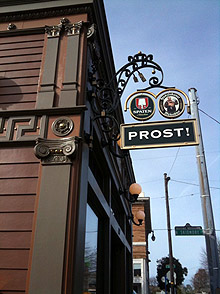 |
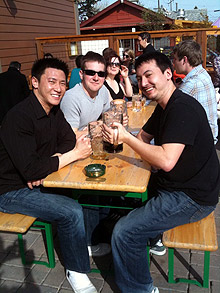 |
Prost, a new pub on Mississippi Avenue and Skidmore hosts a set of food carts adjacent to their outdoor seating area. One can drink beer and eat delicious food from the food carts.
The explosion in numbers of food carts is highly reflective of the food scene in Portland. One should eat from the carts to realize the range of cuisines and excellence that is being offered. In 2008 the Urban Vitality Group partnered with the City of Portland’s Bureau of Planning to study the effects that food carts have on street vitality and neighborhood livability. The study (Food Cartology) identified 170 food carts representing 24 nationalities. The food carts are generally clustered together in “pods,” and these “pods” are becoming magnets for younger people who can get affordable food and a lively social scene—a sort of “restaurant row” effect in miniature. Other findings of the study “indicate that food carts have significant community benefits to neighborhood livability by fostering social interaction, walkability, and by providing interim uses for vacant parcels (of property). Additionally, carts provide good employment opportunities for immigrants and low-income individuals to begin their own businesses, although there are significant barriers to continued stability and success.”21
A recent article, Nancy Rommelman’s “The Art of The Street Cart,” in the September, 2009 Bon Appetit magazine, captured this aspect of life in Portland. Rommelmann opened with the bold assertion that “Portland, Oregon is leading a delicious dining revolution. And it’s not taking place at restaurants—small trucks and mobile carts are serving a range of diverse, inventive, and budget-friendly food.”22 I am personally acquainted with the owners of one of the food carts Rommelmann featured, Monika and Karel Vitek’s Tabor. Natives of the former Czech Republic, they have operated Tabor in downtown Portland for the past 6 years, opening when Monika (the owner) was 27. They feature fresh, high quality, homemade Czech cuisine—otherwise virtually unknown in Portland’s established restaurants.
A more direct affirmation of the importance of this aspect of food culture to life in Portland, though, comes not from critics or urban planners; my 13-year-old daughter and I visited several of the carts during my research for this article, and she continually asks, “When we will go back?!”
Through my research with food cart owners I found out that they often use social media (such as Twitter) to announce daily products, special features and promote their business. Two examples of this are Whiffies Fried Pies and Native Bowl. 23 Clearly these businesses are catering to younger Portlanders.
Whiffies Fried Pies, a food cart on 12th Avenue and Hawthorne Southeast uses Twitter (an electronic social networking service) to inform their young customers when fresh pies are coming out!
Music Scene
Writing in Slate (an online magazine of news, politics, and culture) in late 2007, Taylor Clark proclaimed Portland to be “America’s indie rock theme park.” (“Indie rock” refers to a wide range of independent, underground music.) Clark provides a somewhat whimsical tour of the city, highlighting the homes of members of such alt-rock stalwarts as Modest Mouse, Pavement and Death Cab for Cutie. It is, he wryly notes, “often quipped that Portland is the place where hipsters go to retire.”24 Many of my younger friends and colleagues in Portland play in bands, often more than one.
Clark points out that “Portland has neither a distinctive “sound” nor a “scene” to speak of,” which may contribute to the strong DIY (do-it-yourself) ethic and aesthetic of the youth music scene in Portland. It is difficult, as with any complex social phenomenon, to precisely quantify the number of musicians, bands, and music-related businesses and enterprises. The vitality of a cultural scene may not always be measured in direct terms (number of venues, etc.) as, for example, with the common practice in Portland of “house concerts,” semi-private performances held in venues outside of the normal club circuit.
This participation in local culture generally reflects the findings in the National Endowment for the Arts study referred to earlier (NEA). More specifically, Wieden and Kennedy, an international advertising agency based in Portland, is developing a Web site-based series called, ironically, Don’t Move Here which documents this music scene.25
Sean Flores, a local music producer interviewed for the series, echoes many of the points made by Taylor Clark, describing the Portland music scene as in a renaissance now, and Portland as an easy city to be a musician in. It is, he says, small enough to function as a sort of workshop environment, offering the opportunity to play for an audience of other creative people, and thus accelerating collective music-making.
Rafael (Raf) Spielman is also featured in Don’t Move Here. Raf, 25, plays in numerous bands, as well as creating “Eggy Records,” initially to promote and sell the music produced by the bands he played with, but now expanded to include other bands as well. He prints and packages each cassette by hand. I interviewed Raf as part of my research for this paper and he agrees that for a city the size of Portland we have a very active music scene (number of bands, number of clubs and shows)—he also made special mention of the “house concert” scene, as noted above. This is not, to be sure, unique to Portland, as young musicians that I know have traveled throughout the U.S. only playing at pre-arranged house concerts.
Entering its seventh year, PDX Pop Now! has organized a large, typically three-day, summer festival since 2004. Incorporated as a non-profit organization, the annual festivals typically include performances by upwards of forty local groups. Volunteer-driven and managed, PDX Pop Now! embodies the DIY spirit of active youth music scene in Portland. Along with providing a performance venue, they also issue a two-CD compilation documenting performances from each year’s festival.26
It should be no surprise that in Portland, as elsewhere, the music scene is clearly relying more and more on the increasing use of social media (Facebook, Twitter, Flickr, etc.) to promote events.
Why Here?
Why are these expressions of local culture strong in Portland? My research and experience of living in Portland for 25 years suggests the following factors:
- A temperate climate conducive to being outdoors;
- A relatively progressive environment in which people choose to live in harmony with the natural environment;
- A focus on good health and eating right;
- A generally tolerant environment in which being oneself is OK … it’s OK to play music, to start a food cart, to raise chickens in the city;
- Urban and regional planning which supports a dense city core and the preservation of surrounding rural farmlands;
- Economic development policies supporting small businesses and creative enterprises;
- Increasing numbers of city policies that seek to make Portland a center for sustainable thinking, living, industry, etc.;
- In comparison with other cities (such as Seattle and San Francisco) Portland is an affordable city. One can buy a home. One can have a part-time job to afford the time to start a new venture or play music;
- A history of cooperative ventures and communal living … cooperative farming, record shops, dinner parties, and gardening together;
- Accessibility to the culture, the landscape, and the politics. Portland is not dominated by large corporate employers and landowners. A result is that institutions of “high culture” often struggle for support. On the other hand, individuals and groups are able to initiate new ideas and rather easily reshape significant elements of everyday culture.
Downsides
My conversation with Raf Spielman revealed a shared concern about the negative side of the DIY culture in Portland. An intense pride of place and home-grown culture can often translate into a provincial attitude. Raf mentioned that while we have many bands in Portland, to be truly successful, bands must seek a distribution label from outside Portland. Associated with this provincial attitude is an occasional lack of cutting-edge innovation. Kristin Kennedy, Visual Arts Program Director at PICA (Portland Institute for Contemporary Arts) recently described in a public forum the need to “bring Portland into great dialogue with the rest of the world.”
Some critics also say, paradoxically, that Portland is perhaps too livable, that it lacks the grit and the dynamic conflict necessary to push a city forward. As urban scholar Joel Kotkin put it, “Portland is to today’s generation what San Francisco was to mine: a hip, not too expensive place for young slackers to go.”27 A dancer friend of mine in Portland who often complained of the “niceness” of Portland came back from a trip to New York City where he saw two neighbors screaming at one another—after a few minutes of this, they laughed and embraced one another as neighbors. That’s the dynamic conflict that at least some would say Portland lacks.
Conclusion
Economist Joseph Cortright describes the challenges facing communities as they figure out how to attract young people and root them into place. His assessment of what talented younger people are looking for gives hope to Portland and its youthful green attitude, food culture, and music scene. “Though we are far from having all the answers, focus groups conducted for an earlier research assignment with college-educated recent movers in the 25 to 34 year-old age group identified a coherent set of themes regarding the kinds of things talented young workers are looking for. Our groups discounted claims that young adults are disaffected and uninvolved. They want to live in places that they can be proud of, part of, and that are clean and green. Part of the equation seems to be social and cultural—is this a place that I can be a part of, that I can contribute to? Places with a sense of possibility and opportunity, where the circle is open, where new ideas are welcomed are more likely to attract and retain young adults.”28 Cortright concisely describes the kind of youth culture that I see around me in Portland. While there may be some truth to the idea that Portlanders are often too proud of themselves, I trust that the experiences that young people are having through the cultural dynamics described here will ultimately make them better creative thinkers, environmental stewards, and citizens seeking to live in closer cooperation with others.
Notes
1 Thanks to my friends and colleagues Ethan Seltzer and Martina Kohl who encouraged me to write this paper.
2 National Endowment for the Arts, “2008 Public Participation in the Arts,” Research Report No. 49 (2009).
3 Holly Sidford, “What’s next for Cultural Enterprise? Harnessing Energy and Strategy to Thrive,” Keynote Address at the Oregon Arts Commission Capacity Building Convening, 1 October, 2009.
4 See Oregon Climate Data, Western Regional Climate Center, at http://www.wrcc.dri.edu (accessed April 2, 2010).
5 Chris Palko, “American’s top 20 most liberal-friendly Counties,” The Daily Caller, 9 April, 2010, http://dailycaller.com/2010/04/09/americas-top-20-most-liberal-friendly-counties (accessed April 10, 2010).
6 “The Nation’s Unemployed,”The Wall Street Journal, http://online.wsj.com/public/resources/documents/JOBSMAP09.html (accessed April 2, 2010).
7 See PSU Population Research Center, United States Census Data, at http://www.pdx.edu/prc.
8 See Portland Development Commission, Portland Profile: Facts about the Portland Metropolitan Region at http://pdc.us/factbookonline/index.html.
9 Joseph Cortright, “The Young and Restless in a Knowledge Economy,” CEOs for Cities, December, 2005.
10 Conor Dougherty, “Youth Magnet Cities,” Wall Street Journal, 16 May, 2009.
11 Aaron M. Renn, “Picture-perfect Portland,” The Oregonian, 17 January, 2010.
12 See U.S. Department of Labor, Bureau of Labor Statistics, Unemployment Rates for Metropolitan Areas, February, 2010.
13 “Portland Ranked Greenest U.S. City,” Portland Business Journal, 12 March, 2010, http://portland.bizjournals.com/portland/stories/2010/03/08/daily51.html (accessed April 2, 2010).
14 Joseph Rose, “Portland Falls to No. 2 in a Listing behind a Snowy New Champion,” The Oregonian, 7 April, 2010.
15 Robert Putnam, Bowling Alone: The Collapse and Revival of American Community (New York: Simon and Schuster, 2000).
16 See Oregon Brewers Guild at http://oregonbeer.org.
17 See Slow Flood Portland at http://www.slowfoodportland.com.
18 See Ecotrust at http://www.ecotrust.org.
19 See TOAST at http://www.toastpdx.com.
20 Sarah Gold, “America’s Best Farmers,” Travel + Leisure, April, 2010, http://www.travelandleisure.com/articles/americas-best-farmers-markets/1 (accessed April 2, 2010).
21 See Portland (Oregon) Bureau of Planning and Urban Vitality Group, “Food Cartology: Rethinking Urban Spaces as People Spaces,” at http://www.portlandonline.com/bps/index.cfm?a=200738&c=47477.
22 Nancy Rommelmann, “The Art of the Street Cart,” Bon Appetit, September, 2009.
23 See Whiffies Fried Pies at http://whiffies.com, and Native Bowl at http://nativebowl.blogspot.com.
24 Taylor Clark, “The Indie City: Why Portland is America’s indie rock Mecca,” Slate, 11 September, 2007, http://www.slate.com/id/2173729/ (accessed April 10, 2010).
25 See Don’t Move Here at http://www.wk.com/wke/show/dont_move_here/ .
26 See PDX Pop Now! at http://www.pdxpopnow.com/about.
27 Joel Kotkin, “Welcome to Ecotopia,” Joel Kotkin Blog, comment posted February 22, 2010, http://www.joelkotkin.com/content/00176-welcome-ecotopia (accessed April 10, 2010).
28 Joseph Cortright, “The Young and Restless in a Knowledge Economy,” CEOs for Cities, December, 2005.
Author
http://www.billflood.org
Suggested Citation

This work is licensed under a Creative Commons Attribution-ShareAlike 3.0 Unported License.


